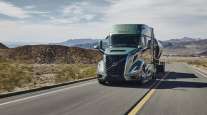Volvo, Navistar Show Off New Tractors for North American Regional Market

This story appears in the April 24 print edition of Transport Topics.
MONTRÉAL — Two heavy-duty truck makers plunged into the North American regional-haul market, unveiling new tractors within hours of each other.
Anticipating a rise in regional work at the expense of longhaul, Volvo Trucks North America showed off its three new VNR models on the evening of April 19, while Navistar Inc. countered the next morning with two variations on the theme of its International RH Class 8s.
The tractors were revealed at ExpoCam, a major Canadian truck show here that ran April 20-22.
Volvo’s VNR will replace the VNM, which has been a mainstay for the Greensboro, N.C.-based company since 1996, and will be available for delivery in September.
VNR’s powertrain will be anchored by the company’s 11- and 13-liter diesel engines and the Volvo I-Shift automated manual transmission. The company also is considering a natural gas option — probably the Cummins Westport ISX 12G — in the near future for fleets working in areas with stringent environmental requirements.
“It is a cool truck that will meet tomorrow’s demand,” VTNA President Göran Nyberg told about 390 guests, including Volvo dealers, customers, staff and trucking reporters.
Navistar had said when it launched its International LT model for linehaul transportation in October that the RH (short for regional haul) would be coming soon. All was quiet until the morning of April 20 at Place Bonaventure.
“You can order it now; we’ll be building them in May and June with market availability in July,” said Jeff Sass, senior vice president for sales and marketing at Lisle, Ill.-based Navistar.
The RH will feature the A26 engine, Navistar’s new 12.4-liter model.
Volvo’s Nyberg said his VNR offers versatility, efficiency and connectivity. It is available for order as of April 24.
Magnus Koeck, vice president of marketing and brand management, said likely applications for the VNR include private fleets, tank truck carriers, less-than-truckload carriers for pickup-and-delivery work, and intermodal drayage providers.
The last VNM will be assembled in late July in Volvo’s Dublin, Va., plant. Then there will be a two-week retooling period, and new VNRs will start rolling down the production line Aug. 14, said Jason Spence, a product marketing manager for Volvo.
The first deliveries are expected to be made in September. Options for cab configuration are a day cab and 42-inch and 61-inch sleeper berth models.
Koeck said designers worked to maximize driver comfort and amenities so as to help fleets retain drivers and recruit new ones.
Nyberg said his new truck is far more than an incremental change to the VNM.
“The whole front package is different. The interior and the steering column are new. We’ve tightened the hood and the bumpers for better aerodynamics. A lot of details have changed,” he said.
Executives with both OEMs said their new vehicles have lengths of 113 inches from bumper to back of cab. Many sleepers are 125 inches BBC, which allows for extra comfort, but a shorter length improves visibility and maneuverability.
Sass said the RH replaces Navistar’s TranStar model. The company expects its next rollout to be its HV series late this year or early 2018 to replace the WorkStar trucks.
RH will be made at Navistar’s Escobedo, Mexico, plant as either a day cab or a 56-inch sleeper.
The VNR was introduced in Canada, but Volvo’s Nyberg said he anticipates selling the model in the United States and Mexico, too.
The VNR will include Volvo’s 6×2 power configuration with a lift axle. Many Canadian provincial governments have regulations against 6×2s in certain cases.
He said VTNA executives are “in talks with Canada to solve the 6×2 problem.”
For a tractor, 6×2 refers to the vehicle’s six wheel-end positions, two of which are powered by the engine.
Volvo is a strong proponent of using a 6×2, in contrast to the more traditional 6×4, arguing that the lift axle is a good way to improve fuel economy.
Volvo executives expect the I-Shift transmission to dominate the choices made by customers but said an Eaton Corp. classic manual will be an option.
Volvo’s Koeck scouted his new competition after he finished launching the VNR. He said the Navistar rollout should not be considered surprising.
“Everyone sees the same sort of trends,” he said, referring to drivers who want regular home time rather than endless life on the road, and an expected boom in container shipping because of the expanded Panama Canal.
“We see growth in regional shipping at the expense of longhaul. I’m sure they [Navistar] see the same thing,” Koeck said.
He said that in 2016, regional tractors were 28% of total U.S. Class 8 sales, and in Canada, they were 21%.
Koeck also spoke about mileage, saying that the new VNR incorporates some of Volvo’s work on the SuperTruck program from the U.S. Department of Energy, including much of the tractor design and shaping, especially the headlamps.




